Impact of Macro Environment on Klarna's Strategies
VerifiedAdded on 2023/01/12
|14
|4554
|79
AI Summary
This report analyzes the impact of the macro environment on Klarna, a global tech bank, and its strategies. It examines the political, economic, social, technological, environmental, and legal factors that influence Klarna's operations. The report also includes a stakeholder analysis and an assessment of Klarna's internal environment and capabilities using the VRIO model and McKinsey's 7s model.
Contribute Materials
Your contribution can guide someone’s learning journey. Share your
documents today.
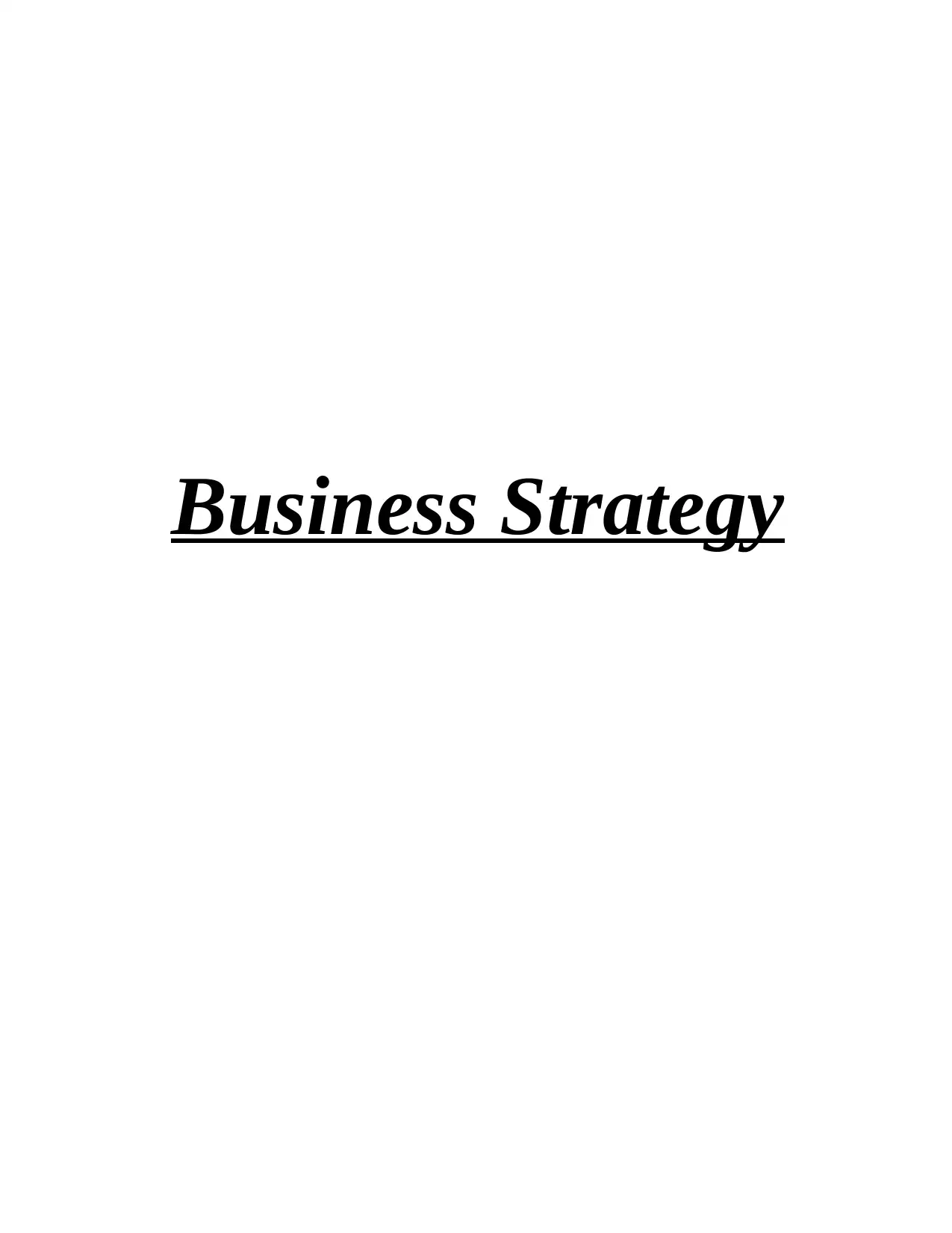
Business Strategy
Secure Best Marks with AI Grader
Need help grading? Try our AI Grader for instant feedback on your assignments.

Table of Contents
INTRODUCTION...........................................................................................................................3
LO 1................................................................................................................................................3
P1. Impact of the macro environment on a given organisation and its strategies..................3
LO 2................................................................................................................................................6
P2 Scrutinize internal environment along with capabilities of Klarna by making use of
appropriate frameworks..........................................................................................................6
LO 3..............................................................................................................................................10
P3 Evaluate competitive forces by making use of Porter’s Five Force model.....................10
LO 4..............................................................................................................................................11
P4 Strategic planning for Klarna..........................................................................................11
CONCLUSION.............................................................................................................................13
REFERENCES..............................................................................................................................14
INTRODUCTION...........................................................................................................................3
LO 1................................................................................................................................................3
P1. Impact of the macro environment on a given organisation and its strategies..................3
LO 2................................................................................................................................................6
P2 Scrutinize internal environment along with capabilities of Klarna by making use of
appropriate frameworks..........................................................................................................6
LO 3..............................................................................................................................................10
P3 Evaluate competitive forces by making use of Porter’s Five Force model.....................10
LO 4..............................................................................................................................................11
P4 Strategic planning for Klarna..........................................................................................11
CONCLUSION.............................................................................................................................13
REFERENCES..............................................................................................................................14
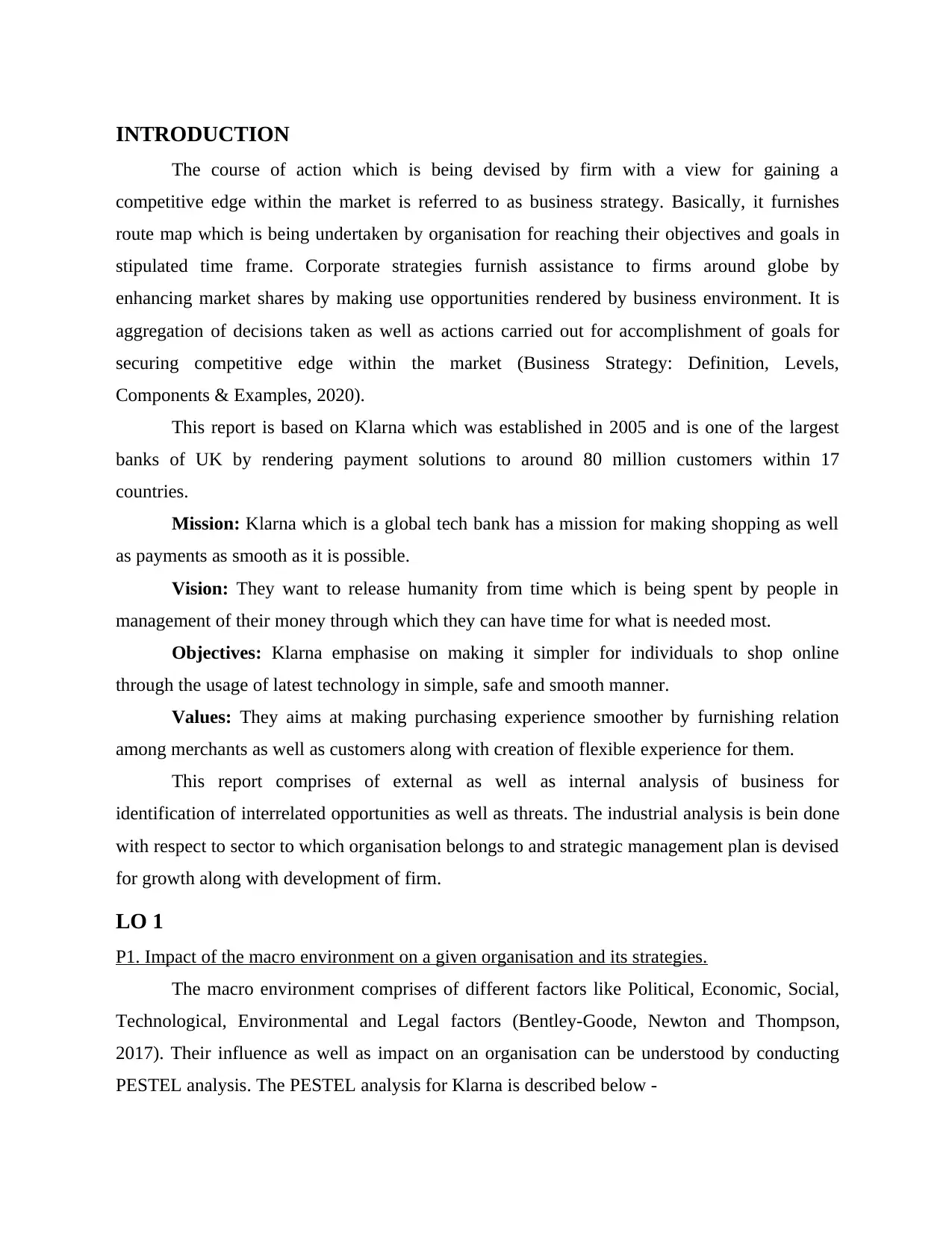
INTRODUCTION
The course of action which is being devised by firm with a view for gaining a
competitive edge within the market is referred to as business strategy. Basically, it furnishes
route map which is being undertaken by organisation for reaching their objectives and goals in
stipulated time frame. Corporate strategies furnish assistance to firms around globe by
enhancing market shares by making use opportunities rendered by business environment. It is
aggregation of decisions taken as well as actions carried out for accomplishment of goals for
securing competitive edge within the market (Business Strategy: Definition, Levels,
Components & Examples, 2020).
This report is based on Klarna which was established in 2005 and is one of the largest
banks of UK by rendering payment solutions to around 80 million customers within 17
countries.
Mission: Klarna which is a global tech bank has a mission for making shopping as well
as payments as smooth as it is possible.
Vision: They want to release humanity from time which is being spent by people in
management of their money through which they can have time for what is needed most.
Objectives: Klarna emphasise on making it simpler for individuals to shop online
through the usage of latest technology in simple, safe and smooth manner.
Values: They aims at making purchasing experience smoother by furnishing relation
among merchants as well as customers along with creation of flexible experience for them.
This report comprises of external as well as internal analysis of business for
identification of interrelated opportunities as well as threats. The industrial analysis is bein done
with respect to sector to which organisation belongs to and strategic management plan is devised
for growth along with development of firm.
LO 1
P1. Impact of the macro environment on a given organisation and its strategies.
The macro environment comprises of different factors like Political, Economic, Social,
Technological, Environmental and Legal factors (Bentley-Goode, Newton and Thompson,
2017). Their influence as well as impact on an organisation can be understood by conducting
PESTEL analysis. The PESTEL analysis for Klarna is described below -
The course of action which is being devised by firm with a view for gaining a
competitive edge within the market is referred to as business strategy. Basically, it furnishes
route map which is being undertaken by organisation for reaching their objectives and goals in
stipulated time frame. Corporate strategies furnish assistance to firms around globe by
enhancing market shares by making use opportunities rendered by business environment. It is
aggregation of decisions taken as well as actions carried out for accomplishment of goals for
securing competitive edge within the market (Business Strategy: Definition, Levels,
Components & Examples, 2020).
This report is based on Klarna which was established in 2005 and is one of the largest
banks of UK by rendering payment solutions to around 80 million customers within 17
countries.
Mission: Klarna which is a global tech bank has a mission for making shopping as well
as payments as smooth as it is possible.
Vision: They want to release humanity from time which is being spent by people in
management of their money through which they can have time for what is needed most.
Objectives: Klarna emphasise on making it simpler for individuals to shop online
through the usage of latest technology in simple, safe and smooth manner.
Values: They aims at making purchasing experience smoother by furnishing relation
among merchants as well as customers along with creation of flexible experience for them.
This report comprises of external as well as internal analysis of business for
identification of interrelated opportunities as well as threats. The industrial analysis is bein done
with respect to sector to which organisation belongs to and strategic management plan is devised
for growth along with development of firm.
LO 1
P1. Impact of the macro environment on a given organisation and its strategies.
The macro environment comprises of different factors like Political, Economic, Social,
Technological, Environmental and Legal factors (Bentley-Goode, Newton and Thompson,
2017). Their influence as well as impact on an organisation can be understood by conducting
PESTEL analysis. The PESTEL analysis for Klarna is described below -
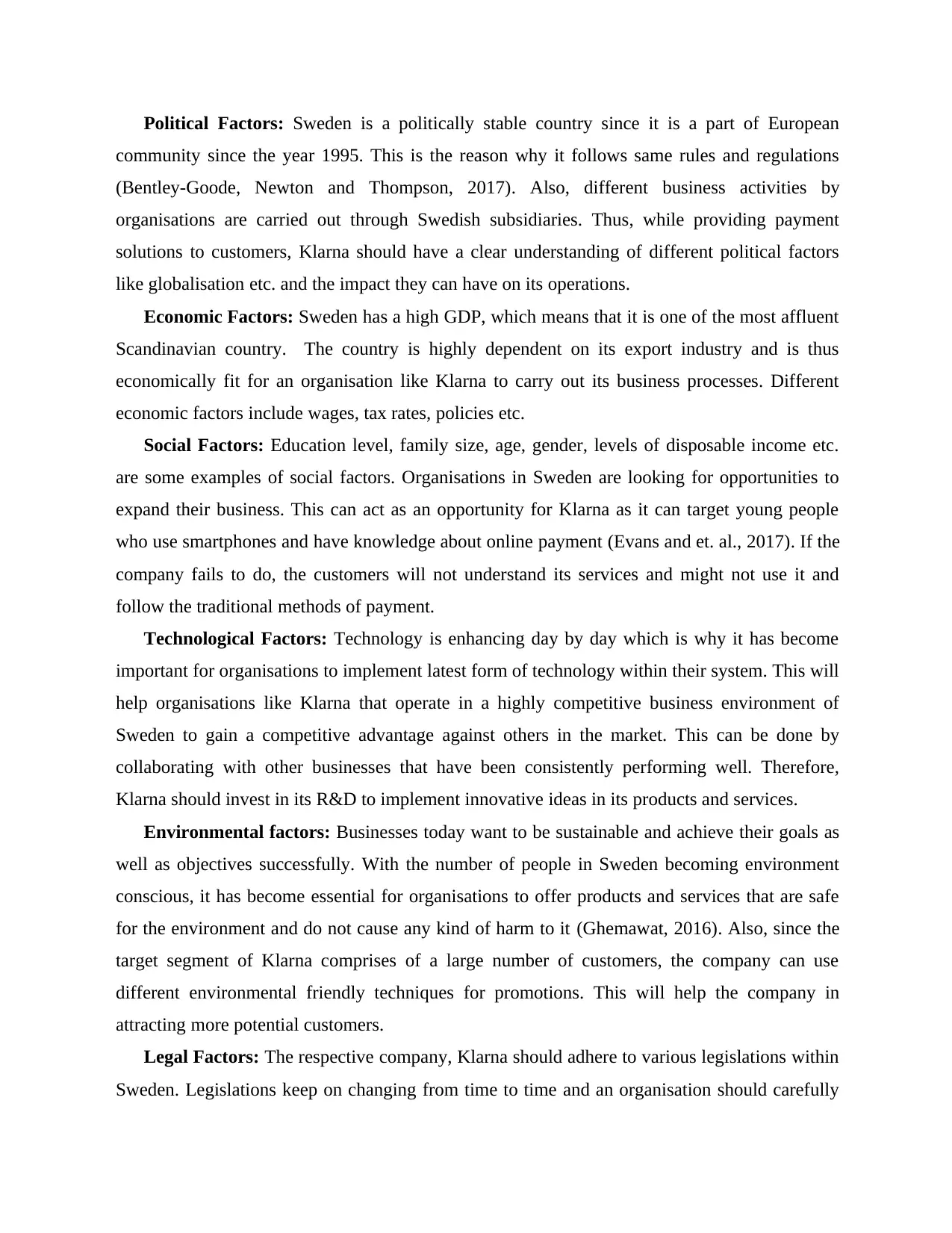
Political Factors: Sweden is a politically stable country since it is a part of European
community since the year 1995. This is the reason why it follows same rules and regulations
(Bentley-Goode, Newton and Thompson, 2017). Also, different business activities by
organisations are carried out through Swedish subsidiaries. Thus, while providing payment
solutions to customers, Klarna should have a clear understanding of different political factors
like globalisation etc. and the impact they can have on its operations.
Economic Factors: Sweden has a high GDP, which means that it is one of the most affluent
Scandinavian country. The country is highly dependent on its export industry and is thus
economically fit for an organisation like Klarna to carry out its business processes. Different
economic factors include wages, tax rates, policies etc.
Social Factors: Education level, family size, age, gender, levels of disposable income etc.
are some examples of social factors. Organisations in Sweden are looking for opportunities to
expand their business. This can act as an opportunity for Klarna as it can target young people
who use smartphones and have knowledge about online payment (Evans and et. al., 2017). If the
company fails to do, the customers will not understand its services and might not use it and
follow the traditional methods of payment.
Technological Factors: Technology is enhancing day by day which is why it has become
important for organisations to implement latest form of technology within their system. This will
help organisations like Klarna that operate in a highly competitive business environment of
Sweden to gain a competitive advantage against others in the market. This can be done by
collaborating with other businesses that have been consistently performing well. Therefore,
Klarna should invest in its R&D to implement innovative ideas in its products and services.
Environmental factors: Businesses today want to be sustainable and achieve their goals as
well as objectives successfully. With the number of people in Sweden becoming environment
conscious, it has become essential for organisations to offer products and services that are safe
for the environment and do not cause any kind of harm to it (Ghemawat, 2016). Also, since the
target segment of Klarna comprises of a large number of customers, the company can use
different environmental friendly techniques for promotions. This will help the company in
attracting more potential customers.
Legal Factors: The respective company, Klarna should adhere to various legislations within
Sweden. Legislations keep on changing from time to time and an organisation should carefully
community since the year 1995. This is the reason why it follows same rules and regulations
(Bentley-Goode, Newton and Thompson, 2017). Also, different business activities by
organisations are carried out through Swedish subsidiaries. Thus, while providing payment
solutions to customers, Klarna should have a clear understanding of different political factors
like globalisation etc. and the impact they can have on its operations.
Economic Factors: Sweden has a high GDP, which means that it is one of the most affluent
Scandinavian country. The country is highly dependent on its export industry and is thus
economically fit for an organisation like Klarna to carry out its business processes. Different
economic factors include wages, tax rates, policies etc.
Social Factors: Education level, family size, age, gender, levels of disposable income etc.
are some examples of social factors. Organisations in Sweden are looking for opportunities to
expand their business. This can act as an opportunity for Klarna as it can target young people
who use smartphones and have knowledge about online payment (Evans and et. al., 2017). If the
company fails to do, the customers will not understand its services and might not use it and
follow the traditional methods of payment.
Technological Factors: Technology is enhancing day by day which is why it has become
important for organisations to implement latest form of technology within their system. This will
help organisations like Klarna that operate in a highly competitive business environment of
Sweden to gain a competitive advantage against others in the market. This can be done by
collaborating with other businesses that have been consistently performing well. Therefore,
Klarna should invest in its R&D to implement innovative ideas in its products and services.
Environmental factors: Businesses today want to be sustainable and achieve their goals as
well as objectives successfully. With the number of people in Sweden becoming environment
conscious, it has become essential for organisations to offer products and services that are safe
for the environment and do not cause any kind of harm to it (Ghemawat, 2016). Also, since the
target segment of Klarna comprises of a large number of customers, the company can use
different environmental friendly techniques for promotions. This will help the company in
attracting more potential customers.
Legal Factors: The respective company, Klarna should adhere to various legislations within
Sweden. Legislations keep on changing from time to time and an organisation should carefully
Paraphrase This Document
Need a fresh take? Get an instant paraphrase of this document with our AI Paraphraser
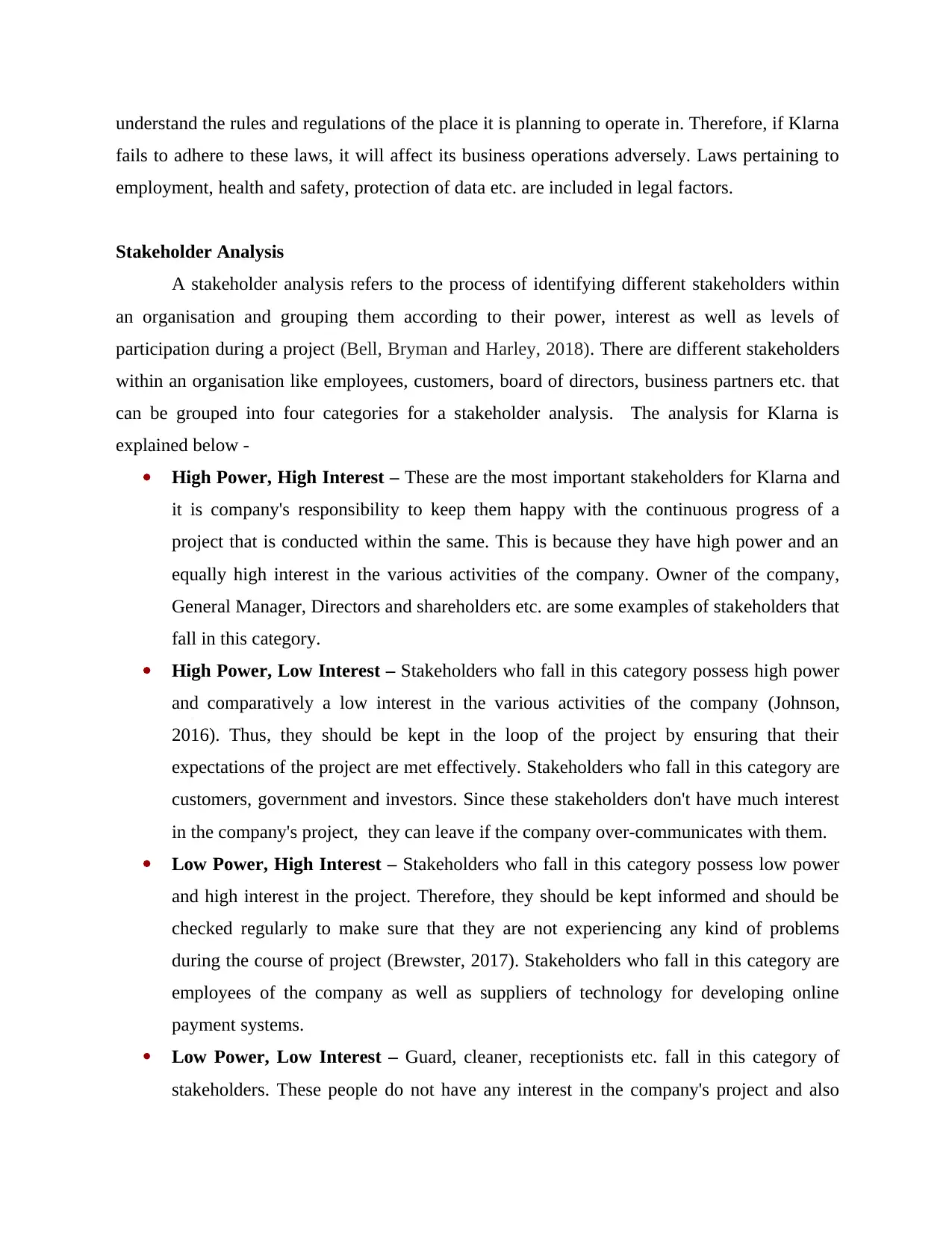
understand the rules and regulations of the place it is planning to operate in. Therefore, if Klarna
fails to adhere to these laws, it will affect its business operations adversely. Laws pertaining to
employment, health and safety, protection of data etc. are included in legal factors.
Stakeholder Analysis
A stakeholder analysis refers to the process of identifying different stakeholders within
an organisation and grouping them according to their power, interest as well as levels of
participation during a project (Bell, Bryman and Harley, 2018). There are different stakeholders
within an organisation like employees, customers, board of directors, business partners etc. that
can be grouped into four categories for a stakeholder analysis. The analysis for Klarna is
explained below -
High Power, High Interest – These are the most important stakeholders for Klarna and
it is company's responsibility to keep them happy with the continuous progress of a
project that is conducted within the same. This is because they have high power and an
equally high interest in the various activities of the company. Owner of the company,
General Manager, Directors and shareholders etc. are some examples of stakeholders that
fall in this category.
High Power, Low Interest – Stakeholders who fall in this category possess high power
and comparatively a low interest in the various activities of the company (Johnson,
2016). Thus, they should be kept in the loop of the project by ensuring that their
expectations of the project are met effectively. Stakeholders who fall in this category are
customers, government and investors. Since these stakeholders don't have much interest
in the company's project, they can leave if the company over-communicates with them.
Low Power, High Interest – Stakeholders who fall in this category possess low power
and high interest in the project. Therefore, they should be kept informed and should be
checked regularly to make sure that they are not experiencing any kind of problems
during the course of project (Brewster, 2017). Stakeholders who fall in this category are
employees of the company as well as suppliers of technology for developing online
payment systems.
Low Power, Low Interest – Guard, cleaner, receptionists etc. fall in this category of
stakeholders. These people do not have any interest in the company's project and also
fails to adhere to these laws, it will affect its business operations adversely. Laws pertaining to
employment, health and safety, protection of data etc. are included in legal factors.
Stakeholder Analysis
A stakeholder analysis refers to the process of identifying different stakeholders within
an organisation and grouping them according to their power, interest as well as levels of
participation during a project (Bell, Bryman and Harley, 2018). There are different stakeholders
within an organisation like employees, customers, board of directors, business partners etc. that
can be grouped into four categories for a stakeholder analysis. The analysis for Klarna is
explained below -
High Power, High Interest – These are the most important stakeholders for Klarna and
it is company's responsibility to keep them happy with the continuous progress of a
project that is conducted within the same. This is because they have high power and an
equally high interest in the various activities of the company. Owner of the company,
General Manager, Directors and shareholders etc. are some examples of stakeholders that
fall in this category.
High Power, Low Interest – Stakeholders who fall in this category possess high power
and comparatively a low interest in the various activities of the company (Johnson,
2016). Thus, they should be kept in the loop of the project by ensuring that their
expectations of the project are met effectively. Stakeholders who fall in this category are
customers, government and investors. Since these stakeholders don't have much interest
in the company's project, they can leave if the company over-communicates with them.
Low Power, High Interest – Stakeholders who fall in this category possess low power
and high interest in the project. Therefore, they should be kept informed and should be
checked regularly to make sure that they are not experiencing any kind of problems
during the course of project (Brewster, 2017). Stakeholders who fall in this category are
employees of the company as well as suppliers of technology for developing online
payment systems.
Low Power, Low Interest – Guard, cleaner, receptionists etc. fall in this category of
stakeholders. These people do not have any interest in the company's project and also
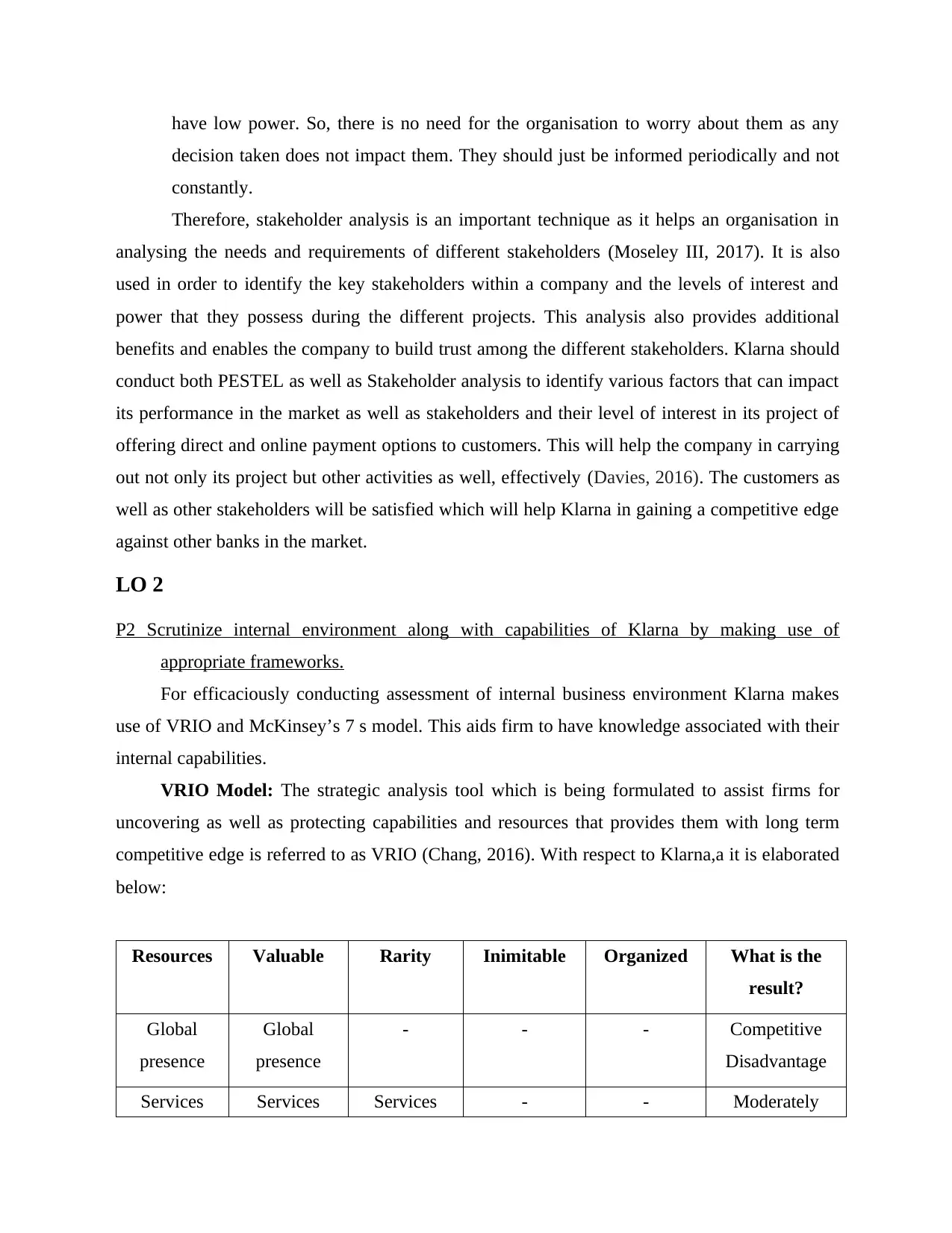
have low power. So, there is no need for the organisation to worry about them as any
decision taken does not impact them. They should just be informed periodically and not
constantly.
Therefore, stakeholder analysis is an important technique as it helps an organisation in
analysing the needs and requirements of different stakeholders (Moseley III, 2017). It is also
used in order to identify the key stakeholders within a company and the levels of interest and
power that they possess during the different projects. This analysis also provides additional
benefits and enables the company to build trust among the different stakeholders. Klarna should
conduct both PESTEL as well as Stakeholder analysis to identify various factors that can impact
its performance in the market as well as stakeholders and their level of interest in its project of
offering direct and online payment options to customers. This will help the company in carrying
out not only its project but other activities as well, effectively (Davies, 2016). The customers as
well as other stakeholders will be satisfied which will help Klarna in gaining a competitive edge
against other banks in the market.
LO 2
P2 Scrutinize internal environment along with capabilities of Klarna by making use of
appropriate frameworks.
For efficaciously conducting assessment of internal business environment Klarna makes
use of VRIO and McKinsey’s 7 s model. This aids firm to have knowledge associated with their
internal capabilities.
VRIO Model: The strategic analysis tool which is being formulated to assist firms for
uncovering as well as protecting capabilities and resources that provides them with long term
competitive edge is referred to as VRIO (Chang, 2016). With respect to Klarna,a it is elaborated
below:
Resources Valuable Rarity Inimitable Organized What is the
result?
Global
presence
Global
presence
- - - Competitive
Disadvantage
Services Services Services - - Moderately
decision taken does not impact them. They should just be informed periodically and not
constantly.
Therefore, stakeholder analysis is an important technique as it helps an organisation in
analysing the needs and requirements of different stakeholders (Moseley III, 2017). It is also
used in order to identify the key stakeholders within a company and the levels of interest and
power that they possess during the different projects. This analysis also provides additional
benefits and enables the company to build trust among the different stakeholders. Klarna should
conduct both PESTEL as well as Stakeholder analysis to identify various factors that can impact
its performance in the market as well as stakeholders and their level of interest in its project of
offering direct and online payment options to customers. This will help the company in carrying
out not only its project but other activities as well, effectively (Davies, 2016). The customers as
well as other stakeholders will be satisfied which will help Klarna in gaining a competitive edge
against other banks in the market.
LO 2
P2 Scrutinize internal environment along with capabilities of Klarna by making use of
appropriate frameworks.
For efficaciously conducting assessment of internal business environment Klarna makes
use of VRIO and McKinsey’s 7 s model. This aids firm to have knowledge associated with their
internal capabilities.
VRIO Model: The strategic analysis tool which is being formulated to assist firms for
uncovering as well as protecting capabilities and resources that provides them with long term
competitive edge is referred to as VRIO (Chang, 2016). With respect to Klarna,a it is elaborated
below:
Resources Valuable Rarity Inimitable Organized What is the
result?
Global
presence
Global
presence
- - - Competitive
Disadvantage
Services Services Services - - Moderately
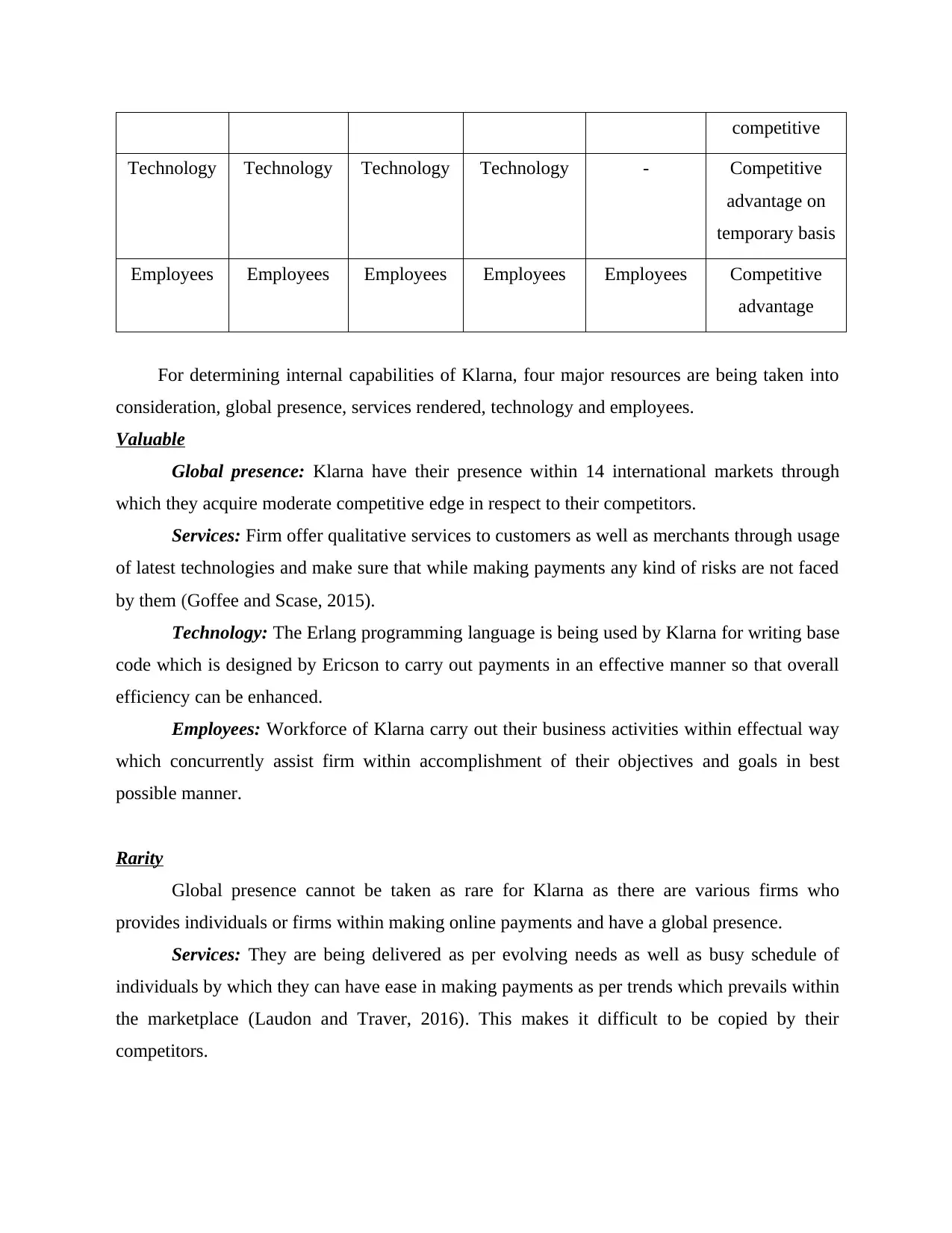
competitive
Technology Technology Technology Technology - Competitive
advantage on
temporary basis
Employees Employees Employees Employees Employees Competitive
advantage
For determining internal capabilities of Klarna, four major resources are being taken into
consideration, global presence, services rendered, technology and employees.
Valuable
Global presence: Klarna have their presence within 14 international markets through
which they acquire moderate competitive edge in respect to their competitors.
Services: Firm offer qualitative services to customers as well as merchants through usage
of latest technologies and make sure that while making payments any kind of risks are not faced
by them (Goffee and Scase, 2015).
Technology: The Erlang programming language is being used by Klarna for writing base
code which is designed by Ericson to carry out payments in an effective manner so that overall
efficiency can be enhanced.
Employees: Workforce of Klarna carry out their business activities within effectual way
which concurrently assist firm within accomplishment of their objectives and goals in best
possible manner.
Rarity
Global presence cannot be taken as rare for Klarna as there are various firms who
provides individuals or firms within making online payments and have a global presence.
Services: They are being delivered as per evolving needs as well as busy schedule of
individuals by which they can have ease in making payments as per trends which prevails within
the marketplace (Laudon and Traver, 2016). This makes it difficult to be copied by their
competitors.
Technology Technology Technology Technology - Competitive
advantage on
temporary basis
Employees Employees Employees Employees Employees Competitive
advantage
For determining internal capabilities of Klarna, four major resources are being taken into
consideration, global presence, services rendered, technology and employees.
Valuable
Global presence: Klarna have their presence within 14 international markets through
which they acquire moderate competitive edge in respect to their competitors.
Services: Firm offer qualitative services to customers as well as merchants through usage
of latest technologies and make sure that while making payments any kind of risks are not faced
by them (Goffee and Scase, 2015).
Technology: The Erlang programming language is being used by Klarna for writing base
code which is designed by Ericson to carry out payments in an effective manner so that overall
efficiency can be enhanced.
Employees: Workforce of Klarna carry out their business activities within effectual way
which concurrently assist firm within accomplishment of their objectives and goals in best
possible manner.
Rarity
Global presence cannot be taken as rare for Klarna as there are various firms who
provides individuals or firms within making online payments and have a global presence.
Services: They are being delivered as per evolving needs as well as busy schedule of
individuals by which they can have ease in making payments as per trends which prevails within
the marketplace (Laudon and Traver, 2016). This makes it difficult to be copied by their
competitors.
Secure Best Marks with AI Grader
Need help grading? Try our AI Grader for instant feedback on your assignments.
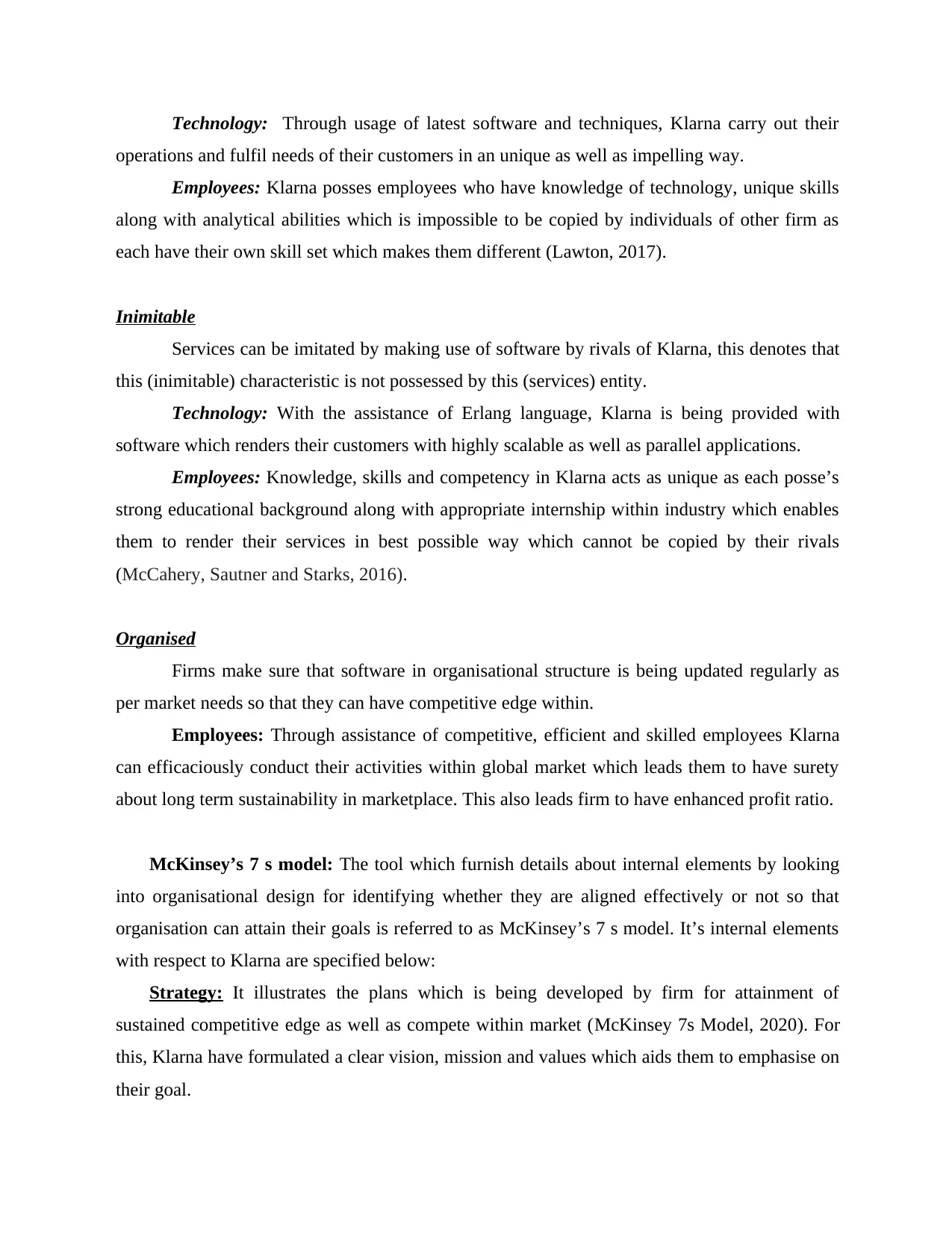
Technology: Through usage of latest software and techniques, Klarna carry out their
operations and fulfil needs of their customers in an unique as well as impelling way.
Employees: Klarna posses employees who have knowledge of technology, unique skills
along with analytical abilities which is impossible to be copied by individuals of other firm as
each have their own skill set which makes them different (Lawton, 2017).
Inimitable
Services can be imitated by making use of software by rivals of Klarna, this denotes that
this (inimitable) characteristic is not possessed by this (services) entity.
Technology: With the assistance of Erlang language, Klarna is being provided with
software which renders their customers with highly scalable as well as parallel applications.
Employees: Knowledge, skills and competency in Klarna acts as unique as each posse’s
strong educational background along with appropriate internship within industry which enables
them to render their services in best possible way which cannot be copied by their rivals
(McCahery, Sautner and Starks, 2016).
Organised
Firms make sure that software in organisational structure is being updated regularly as
per market needs so that they can have competitive edge within.
Employees: Through assistance of competitive, efficient and skilled employees Klarna
can efficaciously conduct their activities within global market which leads them to have surety
about long term sustainability in marketplace. This also leads firm to have enhanced profit ratio.
McKinsey’s 7 s model: The tool which furnish details about internal elements by looking
into organisational design for identifying whether they are aligned effectively or not so that
organisation can attain their goals is referred to as McKinsey’s 7 s model. It’s internal elements
with respect to Klarna are specified below:
Strategy: It illustrates the plans which is being developed by firm for attainment of
sustained competitive edge as well as compete within market (McKinsey 7s Model, 2020). For
this, Klarna have formulated a clear vision, mission and values which aids them to emphasise on
their goal.
operations and fulfil needs of their customers in an unique as well as impelling way.
Employees: Klarna posses employees who have knowledge of technology, unique skills
along with analytical abilities which is impossible to be copied by individuals of other firm as
each have their own skill set which makes them different (Lawton, 2017).
Inimitable
Services can be imitated by making use of software by rivals of Klarna, this denotes that
this (inimitable) characteristic is not possessed by this (services) entity.
Technology: With the assistance of Erlang language, Klarna is being provided with
software which renders their customers with highly scalable as well as parallel applications.
Employees: Knowledge, skills and competency in Klarna acts as unique as each posse’s
strong educational background along with appropriate internship within industry which enables
them to render their services in best possible way which cannot be copied by their rivals
(McCahery, Sautner and Starks, 2016).
Organised
Firms make sure that software in organisational structure is being updated regularly as
per market needs so that they can have competitive edge within.
Employees: Through assistance of competitive, efficient and skilled employees Klarna
can efficaciously conduct their activities within global market which leads them to have surety
about long term sustainability in marketplace. This also leads firm to have enhanced profit ratio.
McKinsey’s 7 s model: The tool which furnish details about internal elements by looking
into organisational design for identifying whether they are aligned effectively or not so that
organisation can attain their goals is referred to as McKinsey’s 7 s model. It’s internal elements
with respect to Klarna are specified below:
Strategy: It illustrates the plans which is being developed by firm for attainment of
sustained competitive edge as well as compete within market (McKinsey 7s Model, 2020). For
this, Klarna have formulated a clear vision, mission and values which aids them to emphasise on
their goal.
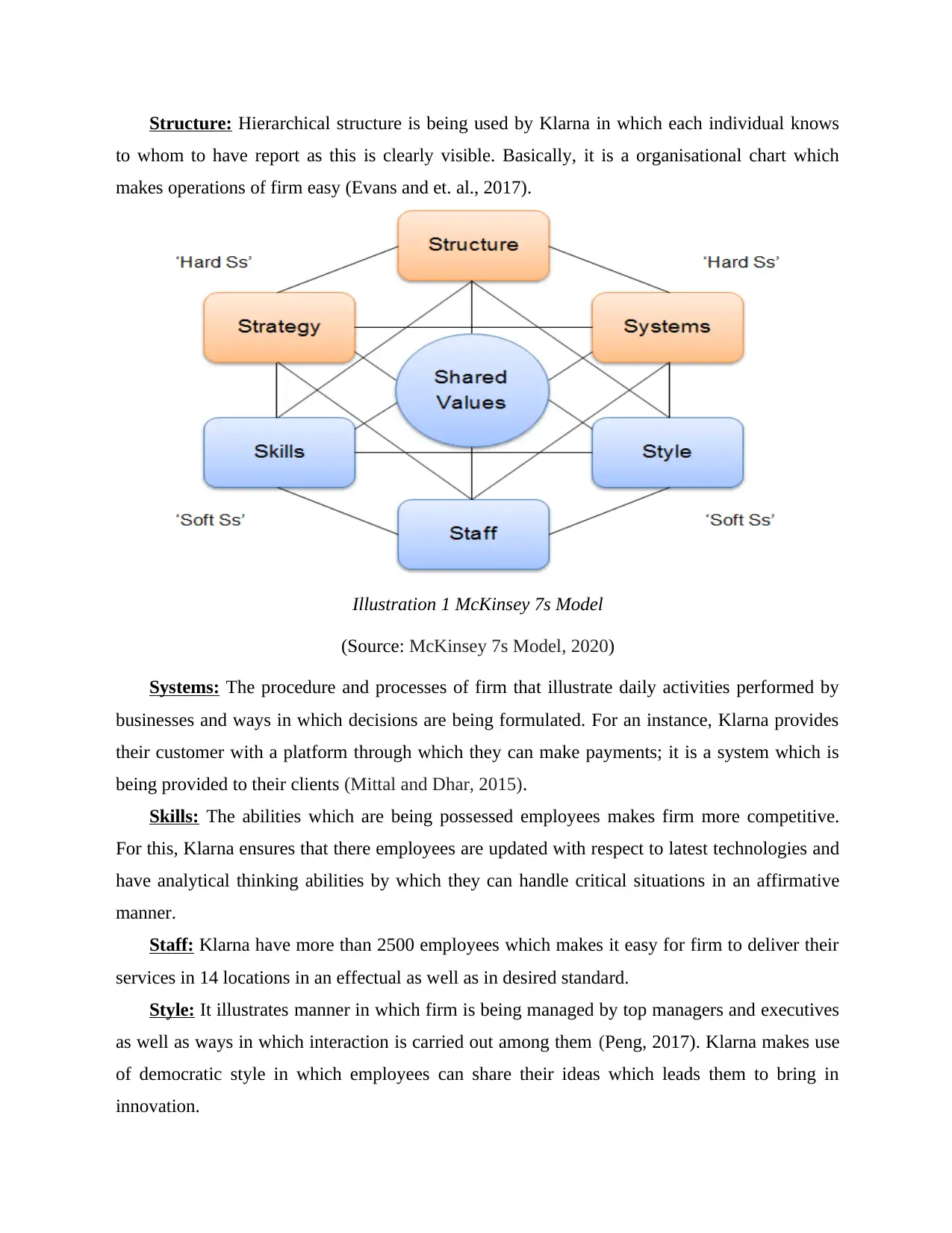
Structure: Hierarchical structure is being used by Klarna in which each individual knows
to whom to have report as this is clearly visible. Basically, it is a organisational chart which
makes operations of firm easy (Evans and et. al., 2017).
Illustration 1 McKinsey 7s Model
(Source: McKinsey 7s Model, 2020)
Systems: The procedure and processes of firm that illustrate daily activities performed by
businesses and ways in which decisions are being formulated. For an instance, Klarna provides
their customer with a platform through which they can make payments; it is a system which is
being provided to their clients (Mittal and Dhar, 2015).
Skills: The abilities which are being possessed employees makes firm more competitive.
For this, Klarna ensures that there employees are updated with respect to latest technologies and
have analytical thinking abilities by which they can handle critical situations in an affirmative
manner.
Staff: Klarna have more than 2500 employees which makes it easy for firm to deliver their
services in 14 locations in an effectual as well as in desired standard.
Style: It illustrates manner in which firm is being managed by top managers and executives
as well as ways in which interaction is carried out among them (Peng, 2017). Klarna makes use
of democratic style in which employees can share their ideas which leads them to bring in
innovation.
to whom to have report as this is clearly visible. Basically, it is a organisational chart which
makes operations of firm easy (Evans and et. al., 2017).
Illustration 1 McKinsey 7s Model
(Source: McKinsey 7s Model, 2020)
Systems: The procedure and processes of firm that illustrate daily activities performed by
businesses and ways in which decisions are being formulated. For an instance, Klarna provides
their customer with a platform through which they can make payments; it is a system which is
being provided to their clients (Mittal and Dhar, 2015).
Skills: The abilities which are being possessed employees makes firm more competitive.
For this, Klarna ensures that there employees are updated with respect to latest technologies and
have analytical thinking abilities by which they can handle critical situations in an affirmative
manner.
Staff: Klarna have more than 2500 employees which makes it easy for firm to deliver their
services in 14 locations in an effectual as well as in desired standard.
Style: It illustrates manner in which firm is being managed by top managers and executives
as well as ways in which interaction is carried out among them (Peng, 2017). Klarna makes use
of democratic style in which employees can share their ideas which leads them to bring in
innovation.

Shared Values: They involves standards as well as norms that are liable for furnishing
appropriate guidelines to behaviour of employees of Klarna.
LO 3
P3 Evaluate competitive forces by making use of Porter’s Five Force model.
This is relevant for firm to take into account competitive forces of market for developing
strategies with respect to this. In this context, administration of Klarna has opted to make use of
Porter Five Force analysis that renders information related with extent of rivalry which prevails
in confines of banking sector.
Porter Five Force Analysis
It is an effectual business tool that is being utilised by firm who have a view for gaining
comprehensibility associated with magnitude of rivalry in a peculiar sector (Scholes, 2015). This
model is liable for rendering assistance to an entity for identification of forces related with
industrial environment that tend to create relevant influence over profitability of firm. According
to this, firm formulates adjustments within corporate strategies. By having an insight into this,
Klarna has carried out industrial analysis which is shown beneath:
Threat of new entrants: The extent of this force in context of finance sector is recognised
to be low. The reason behind this is that due to enhanced investment which is required in form
of capital for gaining entry within this hyper competitive industry. Furthermore, there are
various laws and legislations which have to be followed by firms prevailing within this industry
(Wheelen and et. al., 2017). Therefore, Klarna can have leverage by providing customers with
more secured features for making payments at rapid intervals, thereby reaching maximum
individuals and attaining high profits.
Threat of substitutes: With reference to associated corporate sector, the extent is high.
The reason behind this is that there are various companies who emphasise on delivering options
for making payments such as Skrill, Bread, Wepay, Stripe and Adyen. They also provide the
services with enhanced security features and easy transactions, such top notch firms can seek
people who belongs to loyal base of customers for Klarna (Ghemawat, 2016). This denotes that
peculiar organisation have to diversity their offerings on continuous basis for inflation of
durability within marketplace (Bell, Bryman and Harley, 2018).
appropriate guidelines to behaviour of employees of Klarna.
LO 3
P3 Evaluate competitive forces by making use of Porter’s Five Force model.
This is relevant for firm to take into account competitive forces of market for developing
strategies with respect to this. In this context, administration of Klarna has opted to make use of
Porter Five Force analysis that renders information related with extent of rivalry which prevails
in confines of banking sector.
Porter Five Force Analysis
It is an effectual business tool that is being utilised by firm who have a view for gaining
comprehensibility associated with magnitude of rivalry in a peculiar sector (Scholes, 2015). This
model is liable for rendering assistance to an entity for identification of forces related with
industrial environment that tend to create relevant influence over profitability of firm. According
to this, firm formulates adjustments within corporate strategies. By having an insight into this,
Klarna has carried out industrial analysis which is shown beneath:
Threat of new entrants: The extent of this force in context of finance sector is recognised
to be low. The reason behind this is that due to enhanced investment which is required in form
of capital for gaining entry within this hyper competitive industry. Furthermore, there are
various laws and legislations which have to be followed by firms prevailing within this industry
(Wheelen and et. al., 2017). Therefore, Klarna can have leverage by providing customers with
more secured features for making payments at rapid intervals, thereby reaching maximum
individuals and attaining high profits.
Threat of substitutes: With reference to associated corporate sector, the extent is high.
The reason behind this is that there are various companies who emphasise on delivering options
for making payments such as Skrill, Bread, Wepay, Stripe and Adyen. They also provide the
services with enhanced security features and easy transactions, such top notch firms can seek
people who belongs to loyal base of customers for Klarna (Ghemawat, 2016). This denotes that
peculiar organisation have to diversity their offerings on continuous basis for inflation of
durability within marketplace (Bell, Bryman and Harley, 2018).
Paraphrase This Document
Need a fresh take? Get an instant paraphrase of this document with our AI Paraphraser
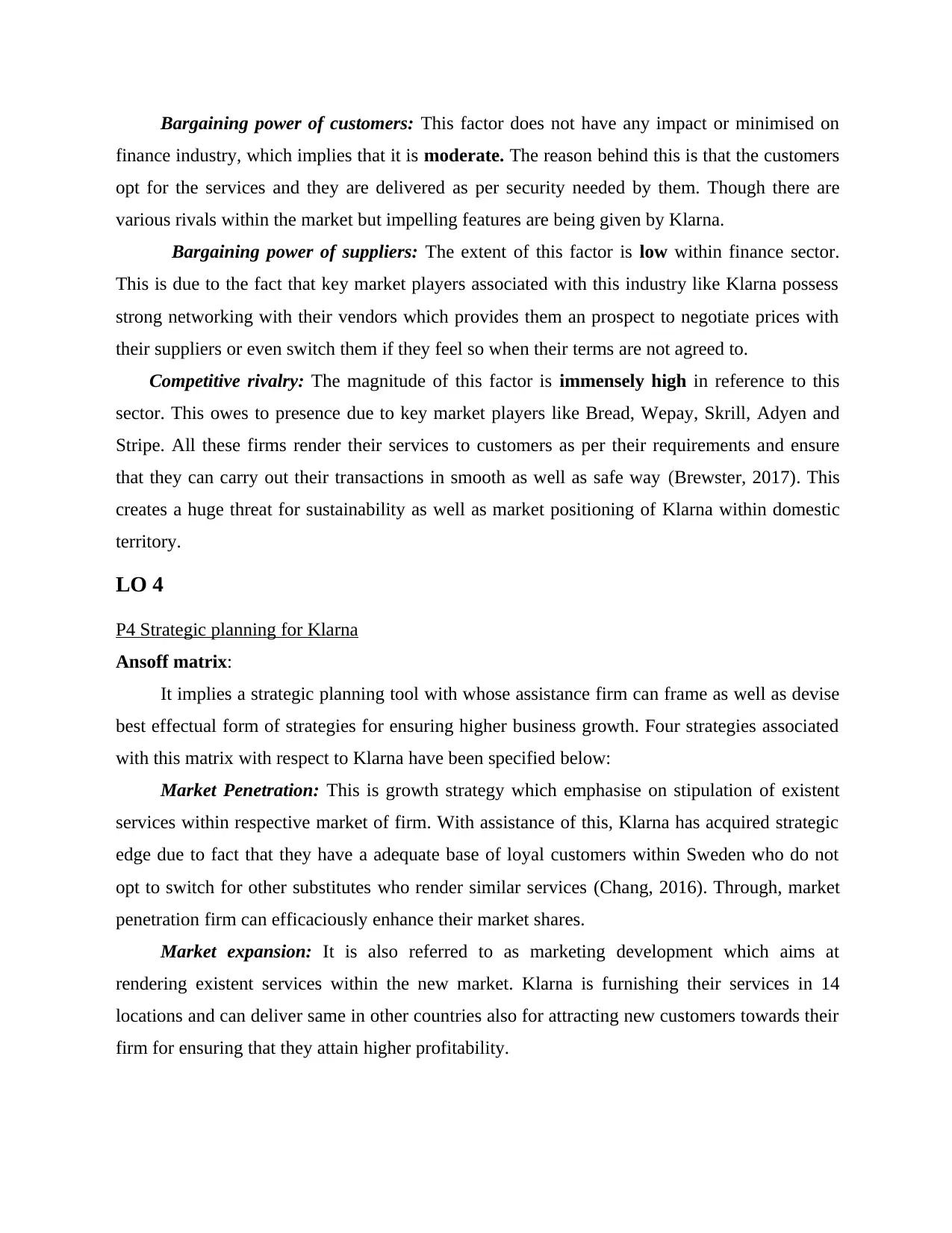
Bargaining power of customers: This factor does not have any impact or minimised on
finance industry, which implies that it is moderate. The reason behind this is that the customers
opt for the services and they are delivered as per security needed by them. Though there are
various rivals within the market but impelling features are being given by Klarna.
Bargaining power of suppliers: The extent of this factor is low within finance sector.
This is due to the fact that key market players associated with this industry like Klarna possess
strong networking with their vendors which provides them an prospect to negotiate prices with
their suppliers or even switch them if they feel so when their terms are not agreed to.
Competitive rivalry: The magnitude of this factor is immensely high in reference to this
sector. This owes to presence due to key market players like Bread, Wepay, Skrill, Adyen and
Stripe. All these firms render their services to customers as per their requirements and ensure
that they can carry out their transactions in smooth as well as safe way (Brewster, 2017). This
creates a huge threat for sustainability as well as market positioning of Klarna within domestic
territory.
LO 4
P4 Strategic planning for Klarna
Ansoff matrix:
It implies a strategic planning tool with whose assistance firm can frame as well as devise
best effectual form of strategies for ensuring higher business growth. Four strategies associated
with this matrix with respect to Klarna have been specified below:
Market Penetration: This is growth strategy which emphasise on stipulation of existent
services within respective market of firm. With assistance of this, Klarna has acquired strategic
edge due to fact that they have a adequate base of loyal customers within Sweden who do not
opt to switch for other substitutes who render similar services (Chang, 2016). Through, market
penetration firm can efficaciously enhance their market shares.
Market expansion: It is also referred to as marketing development which aims at
rendering existent services within the new market. Klarna is furnishing their services in 14
locations and can deliver same in other countries also for attracting new customers towards their
firm for ensuring that they attain higher profitability.
finance industry, which implies that it is moderate. The reason behind this is that the customers
opt for the services and they are delivered as per security needed by them. Though there are
various rivals within the market but impelling features are being given by Klarna.
Bargaining power of suppliers: The extent of this factor is low within finance sector.
This is due to the fact that key market players associated with this industry like Klarna possess
strong networking with their vendors which provides them an prospect to negotiate prices with
their suppliers or even switch them if they feel so when their terms are not agreed to.
Competitive rivalry: The magnitude of this factor is immensely high in reference to this
sector. This owes to presence due to key market players like Bread, Wepay, Skrill, Adyen and
Stripe. All these firms render their services to customers as per their requirements and ensure
that they can carry out their transactions in smooth as well as safe way (Brewster, 2017). This
creates a huge threat for sustainability as well as market positioning of Klarna within domestic
territory.
LO 4
P4 Strategic planning for Klarna
Ansoff matrix:
It implies a strategic planning tool with whose assistance firm can frame as well as devise
best effectual form of strategies for ensuring higher business growth. Four strategies associated
with this matrix with respect to Klarna have been specified below:
Market Penetration: This is growth strategy which emphasise on stipulation of existent
services within respective market of firm. With assistance of this, Klarna has acquired strategic
edge due to fact that they have a adequate base of loyal customers within Sweden who do not
opt to switch for other substitutes who render similar services (Chang, 2016). Through, market
penetration firm can efficaciously enhance their market shares.
Market expansion: It is also referred to as marketing development which aims at
rendering existent services within the new market. Klarna is furnishing their services in 14
locations and can deliver same in other countries also for attracting new customers towards their
firm for ensuring that they attain higher profitability.
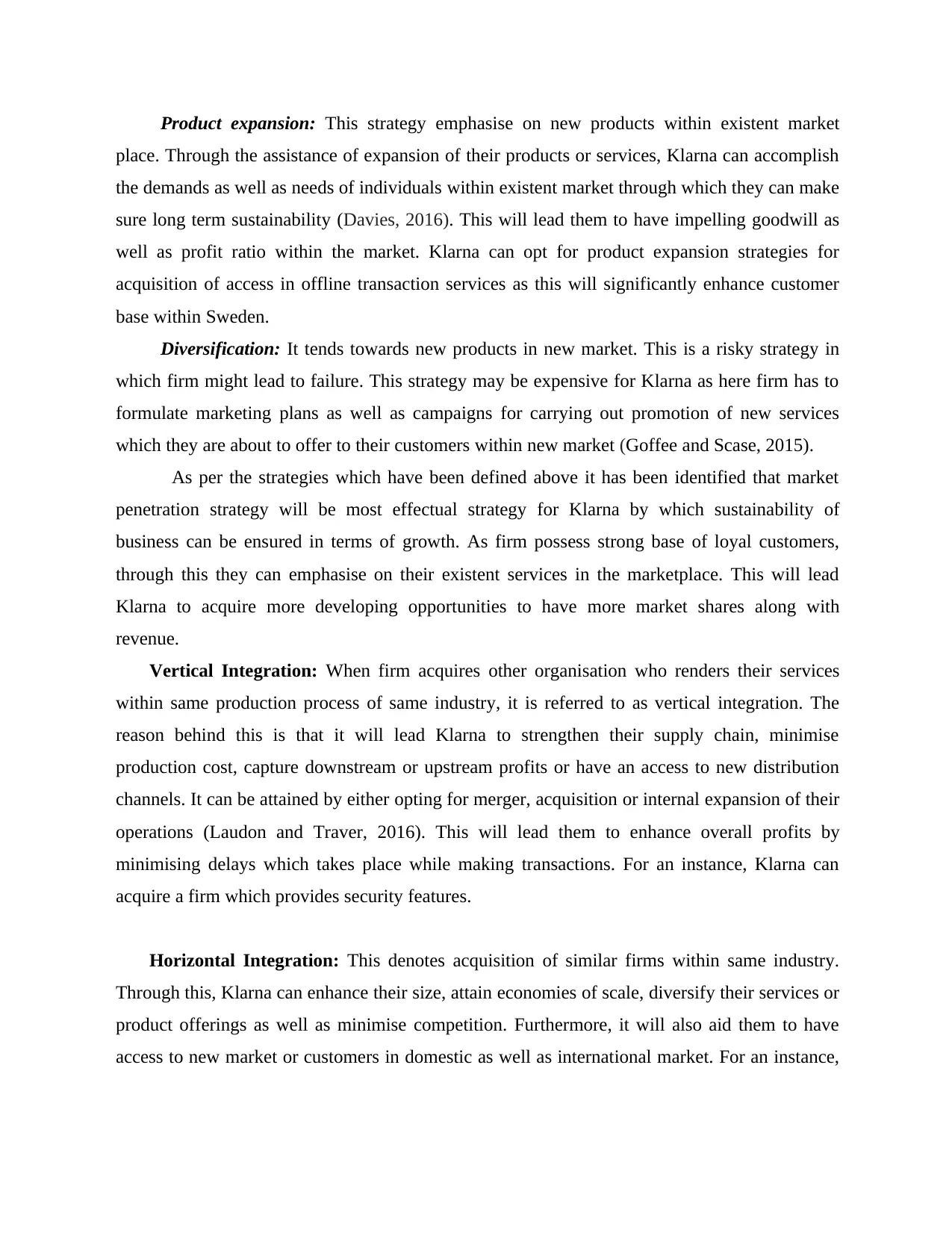
Product expansion: This strategy emphasise on new products within existent market
place. Through the assistance of expansion of their products or services, Klarna can accomplish
the demands as well as needs of individuals within existent market through which they can make
sure long term sustainability (Davies, 2016). This will lead them to have impelling goodwill as
well as profit ratio within the market. Klarna can opt for product expansion strategies for
acquisition of access in offline transaction services as this will significantly enhance customer
base within Sweden.
Diversification: It tends towards new products in new market. This is a risky strategy in
which firm might lead to failure. This strategy may be expensive for Klarna as here firm has to
formulate marketing plans as well as campaigns for carrying out promotion of new services
which they are about to offer to their customers within new market (Goffee and Scase, 2015).
As per the strategies which have been defined above it has been identified that market
penetration strategy will be most effectual strategy for Klarna by which sustainability of
business can be ensured in terms of growth. As firm possess strong base of loyal customers,
through this they can emphasise on their existent services in the marketplace. This will lead
Klarna to acquire more developing opportunities to have more market shares along with
revenue.
Vertical Integration: When firm acquires other organisation who renders their services
within same production process of same industry, it is referred to as vertical integration. The
reason behind this is that it will lead Klarna to strengthen their supply chain, minimise
production cost, capture downstream or upstream profits or have an access to new distribution
channels. It can be attained by either opting for merger, acquisition or internal expansion of their
operations (Laudon and Traver, 2016). This will lead them to enhance overall profits by
minimising delays which takes place while making transactions. For an instance, Klarna can
acquire a firm which provides security features.
Horizontal Integration: This denotes acquisition of similar firms within same industry.
Through this, Klarna can enhance their size, attain economies of scale, diversify their services or
product offerings as well as minimise competition. Furthermore, it will also aid them to have
access to new market or customers in domestic as well as international market. For an instance,
place. Through the assistance of expansion of their products or services, Klarna can accomplish
the demands as well as needs of individuals within existent market through which they can make
sure long term sustainability (Davies, 2016). This will lead them to have impelling goodwill as
well as profit ratio within the market. Klarna can opt for product expansion strategies for
acquisition of access in offline transaction services as this will significantly enhance customer
base within Sweden.
Diversification: It tends towards new products in new market. This is a risky strategy in
which firm might lead to failure. This strategy may be expensive for Klarna as here firm has to
formulate marketing plans as well as campaigns for carrying out promotion of new services
which they are about to offer to their customers within new market (Goffee and Scase, 2015).
As per the strategies which have been defined above it has been identified that market
penetration strategy will be most effectual strategy for Klarna by which sustainability of
business can be ensured in terms of growth. As firm possess strong base of loyal customers,
through this they can emphasise on their existent services in the marketplace. This will lead
Klarna to acquire more developing opportunities to have more market shares along with
revenue.
Vertical Integration: When firm acquires other organisation who renders their services
within same production process of same industry, it is referred to as vertical integration. The
reason behind this is that it will lead Klarna to strengthen their supply chain, minimise
production cost, capture downstream or upstream profits or have an access to new distribution
channels. It can be attained by either opting for merger, acquisition or internal expansion of their
operations (Laudon and Traver, 2016). This will lead them to enhance overall profits by
minimising delays which takes place while making transactions. For an instance, Klarna can
acquire a firm which provides security features.
Horizontal Integration: This denotes acquisition of similar firms within same industry.
Through this, Klarna can enhance their size, attain economies of scale, diversify their services or
product offerings as well as minimise competition. Furthermore, it will also aid them to have
access to new market or customers in domestic as well as international market. For an instance,
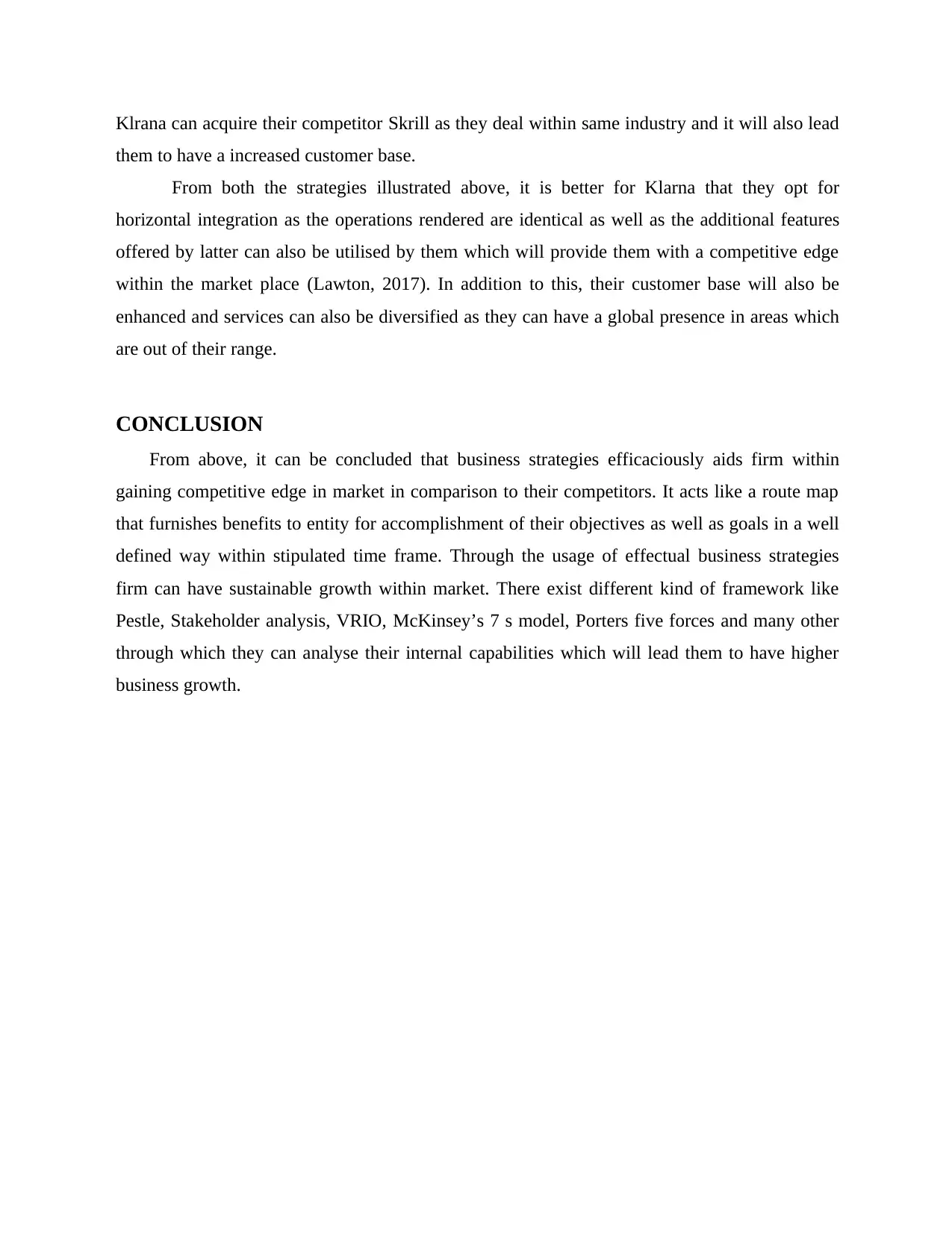
Klrana can acquire their competitor Skrill as they deal within same industry and it will also lead
them to have a increased customer base.
From both the strategies illustrated above, it is better for Klarna that they opt for
horizontal integration as the operations rendered are identical as well as the additional features
offered by latter can also be utilised by them which will provide them with a competitive edge
within the market place (Lawton, 2017). In addition to this, their customer base will also be
enhanced and services can also be diversified as they can have a global presence in areas which
are out of their range.
CONCLUSION
From above, it can be concluded that business strategies efficaciously aids firm within
gaining competitive edge in market in comparison to their competitors. It acts like a route map
that furnishes benefits to entity for accomplishment of their objectives as well as goals in a well
defined way within stipulated time frame. Through the usage of effectual business strategies
firm can have sustainable growth within market. There exist different kind of framework like
Pestle, Stakeholder analysis, VRIO, McKinsey’s 7 s model, Porters five forces and many other
through which they can analyse their internal capabilities which will lead them to have higher
business growth.
them to have a increased customer base.
From both the strategies illustrated above, it is better for Klarna that they opt for
horizontal integration as the operations rendered are identical as well as the additional features
offered by latter can also be utilised by them which will provide them with a competitive edge
within the market place (Lawton, 2017). In addition to this, their customer base will also be
enhanced and services can also be diversified as they can have a global presence in areas which
are out of their range.
CONCLUSION
From above, it can be concluded that business strategies efficaciously aids firm within
gaining competitive edge in market in comparison to their competitors. It acts like a route map
that furnishes benefits to entity for accomplishment of their objectives as well as goals in a well
defined way within stipulated time frame. Through the usage of effectual business strategies
firm can have sustainable growth within market. There exist different kind of framework like
Pestle, Stakeholder analysis, VRIO, McKinsey’s 7 s model, Porters five forces and many other
through which they can analyse their internal capabilities which will lead them to have higher
business growth.
Secure Best Marks with AI Grader
Need help grading? Try our AI Grader for instant feedback on your assignments.
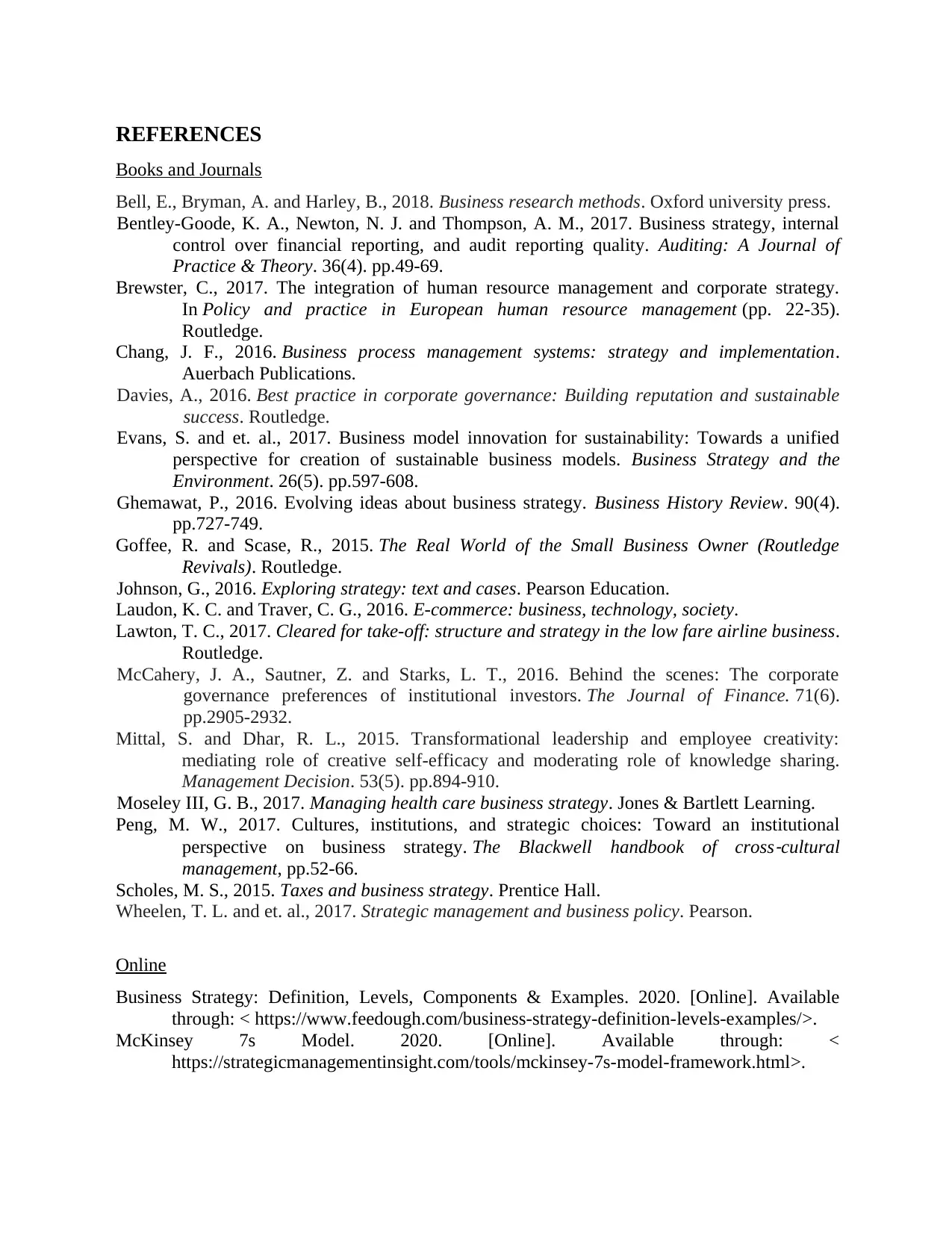
REFERENCES
Books and Journals
Bell, E., Bryman, A. and Harley, B., 2018. Business research methods. Oxford university press.
Bentley-Goode, K. A., Newton, N. J. and Thompson, A. M., 2017. Business strategy, internal
control over financial reporting, and audit reporting quality. Auditing: A Journal of
Practice & Theory. 36(4). pp.49-69.
Brewster, C., 2017. The integration of human resource management and corporate strategy.
In Policy and practice in European human resource management (pp. 22-35).
Routledge.
Chang, J. F., 2016. Business process management systems: strategy and implementation.
Auerbach Publications.
Davies, A., 2016. Best practice in corporate governance: Building reputation and sustainable
success. Routledge.
Evans, S. and et. al., 2017. Business model innovation for sustainability: Towards a unified
perspective for creation of sustainable business models. Business Strategy and the
Environment. 26(5). pp.597-608.
Ghemawat, P., 2016. Evolving ideas about business strategy. Business History Review. 90(4).
pp.727-749.
Goffee, R. and Scase, R., 2015. The Real World of the Small Business Owner (Routledge
Revivals). Routledge.
Johnson, G., 2016. Exploring strategy: text and cases. Pearson Education.
Laudon, K. C. and Traver, C. G., 2016. E-commerce: business, technology, society.
Lawton, T. C., 2017. Cleared for take-off: structure and strategy in the low fare airline business.
Routledge.
McCahery, J. A., Sautner, Z. and Starks, L. T., 2016. Behind the scenes: The corporate
governance preferences of institutional investors. The Journal of Finance. 71(6).
pp.2905-2932.
Mittal, S. and Dhar, R. L., 2015. Transformational leadership and employee creativity:
mediating role of creative self-efficacy and moderating role of knowledge sharing.
Management Decision. 53(5). pp.894-910.
Moseley III, G. B., 2017. Managing health care business strategy. Jones & Bartlett Learning.
Peng, M. W., 2017. Cultures, institutions, and strategic choices: Toward an institutional
perspective on business strategy. The Blackwell handbook of cross
‐cultural
management, pp.52-66.
Scholes, M. S., 2015. Taxes and business strategy. Prentice Hall.
Wheelen, T. L. and et. al., 2017. Strategic management and business policy. Pearson.
Online
Business Strategy: Definition, Levels, Components & Examples. 2020. [Online]. Available
through: < https://www.feedough.com/business-strategy-definition-levels-examples/>.
McKinsey 7s Model. 2020. [Online]. Available through: <
https://strategicmanagementinsight.com/tools/mckinsey-7s-model-framework.html>.
Books and Journals
Bell, E., Bryman, A. and Harley, B., 2018. Business research methods. Oxford university press.
Bentley-Goode, K. A., Newton, N. J. and Thompson, A. M., 2017. Business strategy, internal
control over financial reporting, and audit reporting quality. Auditing: A Journal of
Practice & Theory. 36(4). pp.49-69.
Brewster, C., 2017. The integration of human resource management and corporate strategy.
In Policy and practice in European human resource management (pp. 22-35).
Routledge.
Chang, J. F., 2016. Business process management systems: strategy and implementation.
Auerbach Publications.
Davies, A., 2016. Best practice in corporate governance: Building reputation and sustainable
success. Routledge.
Evans, S. and et. al., 2017. Business model innovation for sustainability: Towards a unified
perspective for creation of sustainable business models. Business Strategy and the
Environment. 26(5). pp.597-608.
Ghemawat, P., 2016. Evolving ideas about business strategy. Business History Review. 90(4).
pp.727-749.
Goffee, R. and Scase, R., 2015. The Real World of the Small Business Owner (Routledge
Revivals). Routledge.
Johnson, G., 2016. Exploring strategy: text and cases. Pearson Education.
Laudon, K. C. and Traver, C. G., 2016. E-commerce: business, technology, society.
Lawton, T. C., 2017. Cleared for take-off: structure and strategy in the low fare airline business.
Routledge.
McCahery, J. A., Sautner, Z. and Starks, L. T., 2016. Behind the scenes: The corporate
governance preferences of institutional investors. The Journal of Finance. 71(6).
pp.2905-2932.
Mittal, S. and Dhar, R. L., 2015. Transformational leadership and employee creativity:
mediating role of creative self-efficacy and moderating role of knowledge sharing.
Management Decision. 53(5). pp.894-910.
Moseley III, G. B., 2017. Managing health care business strategy. Jones & Bartlett Learning.
Peng, M. W., 2017. Cultures, institutions, and strategic choices: Toward an institutional
perspective on business strategy. The Blackwell handbook of cross
‐cultural
management, pp.52-66.
Scholes, M. S., 2015. Taxes and business strategy. Prentice Hall.
Wheelen, T. L. and et. al., 2017. Strategic management and business policy. Pearson.
Online
Business Strategy: Definition, Levels, Components & Examples. 2020. [Online]. Available
through: < https://www.feedough.com/business-strategy-definition-levels-examples/>.
McKinsey 7s Model. 2020. [Online]. Available through: <
https://strategicmanagementinsight.com/tools/mckinsey-7s-model-framework.html>.
1 out of 14
Related Documents
Your All-in-One AI-Powered Toolkit for Academic Success.
+13062052269
info@desklib.com
Available 24*7 on WhatsApp / Email
![[object Object]](/_next/static/media/star-bottom.7253800d.svg)
Unlock your academic potential
© 2024 | Zucol Services PVT LTD | All rights reserved.



